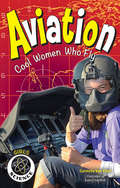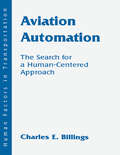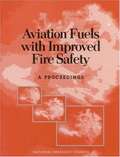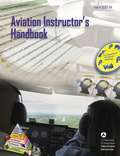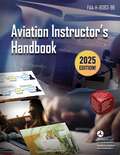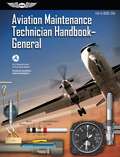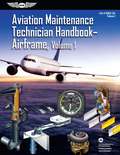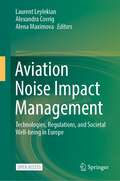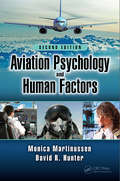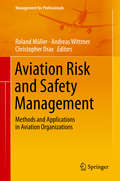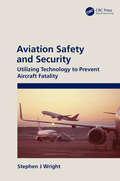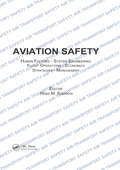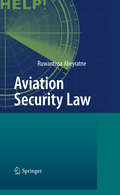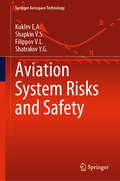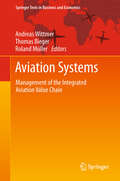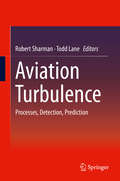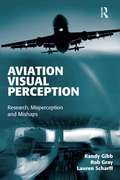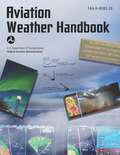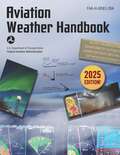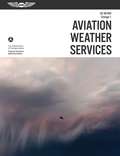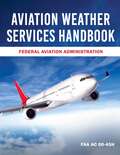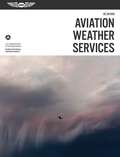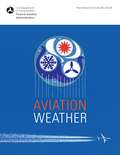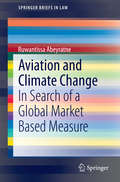- Table View
- List View
Aviation
by Carmella Van VleetHave you ever looked up into the sky, seen an airplane, and wondered where it was going and who was flying it? Aviation is the study of the design, development and production, and operation of aircraft. In Aviation: Cool Women Who Fly, children ages 9 to 12 learn about this fascinating field and meet three successful women working in aviation. Meg Godlewski is a master certified flight instructor, Kristin Wolfe is a pilot in the Air Force, and Taylor McConnell is a production support engineer. Nomad Press books in the Girls in Science series supply a bridge between girls’ interests and their potential futures by investigating science careers and introducing women who have succeeded in science. Compelling stories of real-life aviation experts provide readers with role models that they can look toward as examples of success. Aviation: Cool Women Who Fly uses engaging content, links to primary sources, and essential questions to whet kids’ appetites for further exploration and study of aviation. This book explores the history of aviation, the women who helped pioneer flight, and the multitude of varied careers in this exciting and important field. Both boys and girls are encouraged to let their imaginations and dreams soar.
Aviation Automation: The Search for A Human-centered Approach (Human Factors in Transportation)
by Charles E. BillingsThe advent of very compact, very powerful digital computers has made it possible to automate a great many processes that formerly required large, complex machinery. Digital computers have made possible revolutionary changes in industry, commerce, and transportation. This book, an expansion and revision of the author's earlier technical papers on this subject, describes the development of automation in aircraft and in the aviation system, its likely evolution in the future, and the effects that these technologies have had -- and will have -- on the human operators and managers of the system. It suggests concepts that may be able to enhance human-machine relationships in future systems. The author focuses on the ability of human operators to work cooperatively with the constellation of machines they command and control, because it is the interactions among these system elements that result in the system's success or failure, whether in aviation or elsewhere. Aviation automation has provided great social and technological benefits, but these benefits have not come without cost. In recent years, new problems in aircraft have emerged due to failures in the human-machine relationship. These incidents and accidents have motivated this inquiry into aviation automation. Similar problems in the air traffic management system are predicted as it becomes more fully automated. In particular, incidents and accidents have occurred which suggest that the principle problems with today's aviation automation are associated with its complexity, coupling, autonomy, and opacity. These problems are not unique to aviation; they exist in other highly dynamic domains as well. The author suggests that a different approach to automation -- called "human-centered automation" -- offers potential benefits for system performance by enabling a more cooperative human-machine relationship in the control and management of aircraft and air traffic.
Aviation Fuels with Improved Fire Safety: A Proceedings
by Committee on Aviation Fuels Improved Fire SafetyThe reduction of the fire hazard of fuel is critical to improving survivability in impact-survivable aircraft accidents. Despite current fire prevention and mitigation approaches, fuel flammability can overwhelm post-crash fire scenarios. The Workshop on Aviation Fuels with Improved Fire Safety was held November 19-20, 1996 to review the current state of development, technological needs, and promising technology for the future development of aviation fuels that are most resistant to ignition during a crash. This book contains a summary of workshop discussions and 11 presented papers in the areas of fuel and additive technologies, aircraft fuel system requirements, and the characterization of fuel fires.
Aviation Instructor's Handbook: FAA-H-8083-9A (Faa Handbook Ser.)
by Federal Aviation AdministrationThe Aviation Instructor’s Handbook was developed by the FAA in order to help beginning ground instructors, flight instructors, and aviation maintenance instructors understand the basics of flight instruction. This handbook provides aviation instructors with up-to-date information on learning and teaching, and how to relate this information to the task of teaching aeronautical knowledge and skills to students. Experienced aviation instructors will also find the updated information useful for improving their effectiveness in training activities.
Aviation Instructor's Handbook: FAA-H-8083-9B (Asa Faa Handbook Ser.)
by Federal Aviation AdministrationHere is the official guide, a new edition developed by the FAA, to help beginning ground instructors, flight instructors, and aviation maintenance instructors understand the basics of flight instruction.Heavily illustrated and filled with essential information, topics include:Risk Management and Resource ManagementHuman BehaviorThe Learning ProcessEffective CommunicationThe Teaching ProcessAssessmentInstructor Responsibilities and ProfessionalismTechniques of Flight InstructionAnd much moreThis official FAA publication provides aviation instructors with up-to-date information on learning and teaching, and how to relate this information to the task of teaching aeronautical knowledge and skills to students. Experienced aviation instructors will also find the updated information useful for improving their effectiveness in training activities.
Aviation Maintenance Technician Handbook - General (FAA Handbooks)
by Federal Aviation Administration (FAA)/Aviation Supplies & AcademicsThe Aviation Maintenance Technician Handbook–General (FAA-H-8083-30A) was developed as one of a series of three handbooks for persons preparing for mechanic certification with airframe or powerplant ratings, or both. It is intended that this handbook will provide basic information on principles, fundamentals, and technical procedures in the subject matter areas common to both the airframe and powerplant ratings. Emphasis in this volume is on theory and methods of application. <p><p> The handbook is designed to aid students enrolled in a formal course of instruction preparing for FAA certification as a maintenance technician as well as for current technicians who wish to improve their knowledge. This volume contains information on mathematics, aircraft drawings, weight and balance, aircraft materials, processes and tools, physics, electricity, inspection, ground operations, and FAA regulations governing the certification and work of maintenance technicians. New to this volume is a section addressing how successful aviation maintenance technicians incorporate knowledge and awareness of ethics, professionalism and human factors in the field. <p> Because there are so many different types of airframes and powerplants in use today, it is reasonable to expect that differences exist in the components and systems of each. To avoid undue repetition, the practice of using representative systems and units is implemented throughout the handbook. Subject matter treatment is from a generalized point of view, and should be supplemented by reference to manufacturers’ manuals or other textbooks if more detail is desired. This handbook is not intended to replace, substitute for, or supersede official regulations or the manufacturers’ instructions. <p> The companion handbooks to Aviation Maintenance Technician Handbook–General (FAA-H-8083-30A) are the Aviation Maintenance Technician Handbook–Airframe (FAA-H-8083-31 (as amended)), and the Aviation Maintenance Technician Handbook–Powerplant (FAA-H-8083-32 (as amended)).
Aviation Maintenance Technician Handbook -- General
by FaaThe Aviation Maintenance Technician Handbook--General was developed as one of a series of three handbooks for persons preparing for mechanic certification with airframe or powerplant ratings, or both. It is intended that this handbook will provide basic information on principles, fundamentals, and technical procedures in the subject matter areas common to both the airframe and powerplant ratings. Emphasis in this volume is on theory and methods of application. The handbook is designed to aid students enrolled in a formal course of instruction preparing for FAA certification as a maintenance technician, as well as for current technicians who wish to improve their knowledge.
Aviation Maintenance Technician Handbook: FAA-h-8083-31a, Volume 1 (FAA Handbooks Ser.)
by Federal Aviation Administration (FAA)/Aviation Supplies & AcademicsThe FAA Aviation Maintenance Technician Handbooks are designed for use by instructors and applicants preparing for the FAA Knowledge Exam and Oral & Practical (O&P) Exams required for obtaining an Aviation Maintenance Technician (AMT) certificate with Airframe or Powerplant rating or both (also called an A&P license). Newly updated for 2018, this new edition reflects current technologies, equipment and procedures. These handbooks are for both students and instructors, and also serve as invaluable reference guides for current technicians who wish to improve their knowledge. This is Volume 1 of the FAA's "FAA-H-8083-31A" handbook. This FAA Handbook provides the basic information on principles, fundamentals, and technical procedures in the subject matter areas relating to the airframe and powerplant ratings, such as: Aircraft Structures, Aerodynamics, Aircraft Assembly and Rigging, Aircraft Fabric Covering, Aircraft Metal Structural Repair, Aircraft Welding, Aircraft Wood and Structural Repair, Advanced Composite Materials, Aircraft Painting and Finishing, and Aircraft Electrical System. Illustrated throughout with detailed, full-color drawings and photographs, with a comprehensive glossary and index.
Aviation Noise Impact Management: Technologies, Regulations, and Societal Well-being in Europe
by Laurent Leylekian Alexandra Covrig Alena MaximovaThis open access book provides a view into the state-of-the-art research on aviation noise and related annoyance. The book will primarily focus on the achievements of the ANIMA project (Aviation Noise Impact Management through Novel Approaches), but not exclusively.The content has a broader theme in order to encompass. regulation issues, the ICAO (International Civil Aviation Organization) balanced approach, progresses made on technologies and reduction of noise at source, impact of possible future civil supersonic aircraft, land-use planning issues, as well as the core topics of the ANIMA project, i.e. impact on human beings, annoyance, quality of life, health and findings of the project in this respect.This book differs from traditional research programmes on aviation noise as the authors endeavour, not to lower noise at source, but to reduce the annoyance. This book examines these non-acoustic factors in an effort to help those most affected by aviation noise – communities living close to airports, and also help airport managers, policy-makers, local authorities and researchers to deal with this issue holistically. The book concludes with some recommendations for EU, national and local policy-makers, airport and aviation authorities, and more broadly a scientifically literate audience. These recommendations may help to identify gaps for progress in terms of research but also genuine implementation actions for political and regulatory authorities.
Aviation Psychology and Human Factors
by Monica Martinussen David R. HunterThis book covers the application of psychological principles and techniques to situations and problems of aviation. It offers an overview of the role psychology plays in aviation, system design, selection and training of pilots, characteristics of pilots, safety, and passenger behavior. It covers concepts of psychological research and data analysis and shows how these tools are used in the development of new psychological knowledge. The new edition offers material on physiological effects on pilot performance, a new chapter on aviation physiology, more material on fatigue, safety culture, mental health and safety, as well as practical examples and exercises after each chapter.
Aviation Risk and Safety Management: Methods and Applications in Aviation Organizations (Management for Professionals)
by Andreas Wittmer Roland Müller Christopher DraxThe International Civil Aviation Organization's (ICAO) decision to require aviation organizations to adopt Safety Management Systems poses a major problem especially for small and medium sized aviation companies. The complexity of regulations overstrains the aviation stakeholders who seek to fully advantage from them but have no clear guidance. The aim of the book is to show the implementation of such a new system with pragmatic effort in order to gain a gradation for smaller operators. This approach should illustrate the leeway in order to adapt the processes and to show the interfaces between Corporate Risk Management and Safety Management. The book shows how to build a system with reasonable effort, appropriate to the size and complexity of the specific operator. It also gives inputs on the key aspects and how to effectively operate such a system with the various interfaces. Furthermore, the book highlights the importance of Corporate Risk Management independent of Safety Management Systems based on ICAO.
Aviation Safety and Security: Utilizing Technology to Prevent Aircraft Fatality
by Stephen J WrightThis book focuses on ways to better manage and prevent aircraft-based homicide events while in flight using alternate technology to replace the Cockpit Voice Recorder (CVR) and/or Digital Flight Data Recorder (DFDR) functions. While these events are infrequent, the implementation of real-time predictive maintenance allows aircraft operators to better manage both scheduled and unscheduled maintenance events. Aviation Safety and Security: Utilizing Technology to Prevent Aircraft Fatality explores historical events of in-flight homicide and includes relevant accident case study excerpts from the National Transportation Safety Board (NTSB) and Air Accidents Investigation Branch (AAIB). FEATURES Explores historical events of in-flight homicide and offers solutions for ways to mitigate risk Explains how alternate technologies can be implemented to address in-flight safety issues Demonstrates that metrics for change are not solely for safety but also for financial savings for aircraft operation Includes relevant accident case study excerpts from the NTSB and AAIB Expresses the need for real-time predictive maintenance Stephen J Wright is an academic Professor at the faculty of Engineering and Natural Sciences at Tampere University, Finland, specializing in aviation, aeronautical engineering, and aircraft systems.
Aviation Safety, Human Factors - System Engineering - Flight Operations - Economics - Strategies - Management
by Hans M. SoekkhaQuestions concerning safety in aviation attract a great deal of attention, due to the growth in this industry and the number of fatal accidents in recent years. The aerospace industry has always been deeply concerned with the permanent prevention of accidents and the conscientious safeguarding of all imaginable critical factors surrounding the organization of processes in aeronautical technology. However, the developments in aircraft technology and control systems require further improvements to meet future safety demands. This book embodies the proceedings of the 1997 International Aviation Safety Conference, and contains 60 talks by internationally recognized experts on various aspects of aviation safety. Subjects covered include: Human interfaces and man-machine interactions; Flight safety engineering and operational control systems; Aircraft development and integrated safety designs; Safety strategies relating to risk insurance and economics; Corporate aspects and safety management factors --- including airlines services and airport security environment.
Aviation Security Law
by Ruwantissa AbeyratneThe law plays a significant role in ensuring aviation security. This book addresses new and emerging threats to civil aviation; evaluates security tools now in use such as the Public Key Directory, Advance Passenger Information, Passenger Name Record and Machine Readable travel documents in the context of their legal and regulatory background; and discusses applicable security treaties while providing an insight into the process of the security audits conducted by the International Civil Aviation Organization (ICAO). The book also examines issues of legal responsibility of States and individuals for terrorist acts of third parties against civil aviation and discusses from a legal perspective the latest liability Conventions adopted at ICAO. The Conclusion of the book provides an insight into the application oflegal principles through risk management.
Aviation System Risks and Safety (Springer Aerospace Technology)
by Shatrakov Y.G. Kuklev E.A. Shapkin V.S. Filippov V.L.This book provides a solution to “rare event” problems without using the classical theory of reliability and theory of probability. This solution is based on the methodology of risk assessment as “measure of danger” (in keeping with the ICS RAS) and an expert approach to determining systems’ safety indications using Fuzzy Sets methods. Further, the book puts forward a new concept: “Reliability, Risks, and Safety” (RRS). The book’s main goal is to generalize present results and underscore the need to develop an alternative approach to safety level assessment and risk management for technical (aviation) systems in terms of Fuzzy Sets objects, in addition to traditional probabilistic safety analysis (PSA). The concept it proposes incorporates ICAO recommendations regarding proactive system control and the system’s responses to various internal and external disturbances.
Aviation Systems: Management of the Integrated Aviation Value Chain (Springer Texts in Business and Economics)
by Andreas Wittmer Thomas Bieger Roland MüllerThis book aims to provide comprehensive coverage of the field of air transportation, giving attention to all major aspects, such as aviation regulation, economics, management and strategy. The book approaches aviation as an interrelated economic system and in so doing presents the "big picture" of aviation in the market economy. It explains the linkages between domains such as politics, society, technology, economy, ecology, regulation and how these influence each other. Examples of airports and airlines, and case studies in each chapter support the application-oriented approach. Students and researchers in business administration with a focus on the aviation industry, as well as professionals in the industry looking to refresh or broaden their knowledge of the field will benefit from this book.
Aviation Turbulence: Processes, Detection, Prediction
by Robert Sharman Todd LaneAnyone who has experienced turbulence in flight knows that it is usually not pleasant, and may wonder why this is so difficult to avoid. The book includes papers by various aviation turbulence researchers and provides background into the nature and causes of atmospheric turbulence that affect aircraft motion, and contains surveys of the latest techniques for remote and in situ sensing and forecasting of the turbulence phenomenon. It provides updates on the state-of-the-art research since earlier studies in the 1960s on clear-air turbulence, explains recent new understanding into turbulence generation by thunderstorms, and summarizes future challenges in turbulence prediction and avoidance.
Aviation Visual Perception: Research, Misperception and Mishaps (Ashgate Studies in Human Factors for Flight Operations)
by Rob Gray Randy Gibb Lauren ScharffVision is the dominant sense used by pilots and visual misperception has been identified as the primary contributing factor in numerous aviation mishaps, resulting in hundreds of fatalities and major resource loss. Despite physiological limitations for sensing and perceiving their aviation environment, pilots can often make the required visual judgments with a high degree of accuracy and precision. At the same time, however, visual illusions and misjudgments have been cited as the probable cause of numerous aviation accidents, and in spite of technological and instructional efforts to remedy some of the problems associated with visual perception in aviation, mishaps of this type continue to occur. Clearly, understanding the role of visual perception in aviation is key to improving pilot performance and reducing aviation mishaps. This book is the first dedicated to the role of visual perception in aviation, and it provides a comprehensive, single-source document encompassing all aspects of aviation visual perception. Thus, this book includes the foundations of visual and vestibular sensation and perception; how visual perceptual abilities are assessed in pilots; the pilot's perspective of visual flying; a summary of human factors research on the visual guidance of flying; examples of specific visual and vestibular illusions and misperceptions; mishap analyses from military, commercial and general aviation; and, finally, how this knowledge is being used to better understand visual perception in aviation's next generation. Aviation Visual Perception: Research, Misperception and Mishaps is intended to be used for instruction in academia, as a resource for human factors researchers, design engineers, and for instruction and training in the pilot community.
Aviation Weather Handbook (2024): FAA-H-8083-28
by Federal Aviation AdministrationTHE ESSENTIAL FULL-COLOR WEATHER HANDBOOK FOR PILOTS! This handbook consolidates the weather information from six FAA weather-related advisory circulars (AC) into one useful publication. The following ACs will eventually be cancelled and replaced by this handbook: AC 00-06, Aviation Weather AC 00-24, Thunderstorms AC 00-30, Clear Air Turbulence Avoidance AC 00-45, Aviation Weather Services AC 00-54, Pilot Windshear Guide AC 00-57, Hazardous Mountain Winds The FAA designed Aviation Weather Handbook as a technical reference for all who operate in the National Aerospace System (NAS). Pilots, dispatchers, and operators will find this handbook a valuable resource for flight planning and decision making. With a complete guide to the United States' aviation weather program, products, and services, it also documents weather theory and its application to aviation. The objective of this handbook is to help the pilot and operator understand the basics of weather, aviation weather hazards, and aviation weather products. Beginners and advanced pilots alike will find the Aviation Weather Handbook to be a critical resource for all aviation weather subjects.
Aviation Weather Handbook (2025): FAA-H-8083-28A
by Federal Aviation AdministrationTHE ESSENTIAL FULL-COLOR WEATHER HANDBOOK FOR PILOTS IN 2025! This full-color handbook, released by the Federal Aviation Administration in December 2024, supersedes the first edition FAA-H-8083-28, Aviation Weather Handbook, dated 2022. This handbook consolidates the weather information from six FAA weather-related advisory circulars (AC) into one useful publication. The following ACs were canceled and replaced by this handbook: AC 00-06, Aviation Weather AC 00-24, Thunderstorms AC 00-30, Clear Air Turbulence Avoidance AC 00-45, Aviation Weather Services AC 00-54, Pilot Windshear Guide AC 00-57, Hazardous Mountain Winds The FAA designed Aviation Weather Handbook as a technical reference for all who operate in the National Aerospace System (NAS). Pilots, dispatchers, and operators will find this handbook a valuable resource for flight planning and decision making. With a complete guide to the United States' aviation weather program, products, and services, it also documents weather theory and its application to aviation. The objective of this handbook is to help the pilot and operator understand the basics of weather, aviation weather hazards, and aviation weather products. Beginners and advanced pilots alike will find the Aviation Weather Handbook to be a critical resource for all aviation weather subjects.
Aviation Weather Services
by Federal Aviation Federal Aviation Administration<p>Published the Federal Aviation Administration (FAA), with the participation of the National Weather Service, this FAA Advisory Circular (AC) 00-45H explains the U.S. aviation weather products and services available to pilots. With full-color illustrations throughout, it details the interpretation and application of advisories, coded weather reports, forecasts, observed and prognostic weather charts, and radar and satellite imagery. <p>Readers will find full coverage of weather-related tools to assist every pilot’s flight planning and in‑flight decisions. Weather product examples and explanations are supported with hundreds of weather website references for further resources, definitions, and additional related FAA publications. Applicable to both VFR and IFR pilots, low and high-altitude operations, this new edition now includes weather resources for soaring, space, and helicopter emergency medical services (HEMS). <p>This book is the weather services resource to use when studying for pilot certification exams and should remain a part of every aviator’s library. Subjects covered include METARs, Pilot Reports (PIREPs), the new Graphical Forecast for Aviation (GFA), SIGMETs, AIRMETs, Terminal Aerodrome Forecasts (TAF), Significant Weather Charts and much more. With additional weather station location tables, symbols and conversion charts, internet links and more, this book is key for all pilots seeking an understanding of the weather resources available for preflight and inflight decision-making.</p>
Aviation Weather Services Handbook: FAA AC 00-45H (Asa Faa Handbook Ser.)
by Federal Aviation AdministrationThis official handbook provides an authoritative weather tool for pilots, flight instructors, and those studying for pilot certification. From the Federal Aviation Administration with contributions from the National Weather Service and National Oceanic and Atmospheric Administration, this edition offers up-to-date information on the interpretation and usage of U.S. aviation weather products and services. Revised to take into account the phasing-out of some traditional weather products in favor of newer web-based tools, this newly organized guide can help pilots and operators use every available tool to plan safe and efficient flights. Color photographs, satellite images, diagrams, charts, and other illustrations enhance understanding of weather as it applies to flight and make this book an exhaustive resource no aviator or aeronautical buff should be without. Chapters included in the Aviation Weather Services Handbook are: Aviation Weather Service Program, Aviation Weather Product Policy, Observations, Analysis, Forecasts, and Aviation Weather Tools. Readers will also find useful appendices with definitions of common terms used in en route forecasts and advisories, a standard conversion chart, density altitude calculation, and a map of weather radar network sites. Educational, comprehensive, and potentially lifesaving, this is an indispensable manual for anyone involved in handling a plane.
Aviation Weather Services: Advisory Circular (FAA Handbooks)
by Federal Aviation AdministrationPublished the Federal Aviation Administration (FAA), with the participation of the National Weather Service, this FAA Advisory Circular (AC) 00-45H explains the U.S. aviation weather products and services available to pilots. it details the interpretation and application of advisories, coded weather reports, forecasts, observed and prognostic weather charts, and radar and satellite imagery. <P><P>Readers will find full coverage of weather-related tools to assist every pilot’s flight planning and in‑flight decisions. Weather product examples and explanations are supported with hundreds of weather website references for further resources, definitions, and additional related FAA publications. <P><P>This book is the weather services resource to use when studying for pilot certification exams. This book is key for all pilots seeking an understanding of the weather resources available for preflight and inflight decision-making.
Aviation Weather: FAA Advisory Circular (AC) 00-6B (FAA Handbooks Ser.)
by Federal Aviation AdministrationAviation Weather is a comprehensive resource for everything that pilots, students, and instructors need to know about navigating all types of weather safely. This book covers both visual (VMC) and instrument (IMC) meteorological conditions, and does so using detailed illustrations and diagrams. Subjects covered include the earth’s atmosphere, temperatures, atmospheric pressure and altimetry, wind, moisture, precipitation, clouds, air masses and fronts, turbulence, icing, thunderstorms, common IFR producers, high altitude weather, arctic and tropical weather, and soaring weather. A detailed glossary and index are provided for guidance.
Aviation and Climate Change: In Search of a Global Market Based Measure (SpringerBriefs in Law)
by Ruwantissa AbeyratneThe book addresses the most critical issue faced by aviation and climate change: namely the development of a market based measure to control aircraft engine emissions. It discusses the current market economic trends as they impact to aviation and suggests steps and measures to be taken in the development of a workable MBM. ICAO has three years to come up with such an MBM on a global scale and this book will spur discussions on how to achieve this objective.
